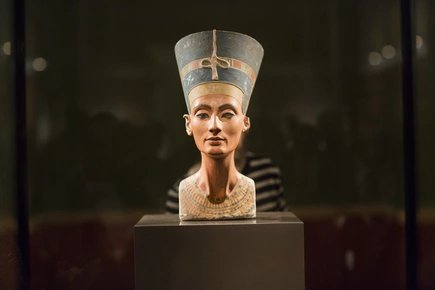
Old St. Matthäus Churchyard
Snow White and the King of Germany
Visit Rio Reiser and the Brothers Grimm at the Alter St. Matthäus-Kirchhof. The cemetery tells Berlin’s story from the 19th century to the present day.
A cemetery full of fairy tales – from Snow White to the Frog King to the König von Deutschland. A cemetery full of real-life stories – the fight against diseases, the struggle for tolerance and resistance against dictatorship. The Alter St. Matthäus-Kirchhof has many tales to tell.
History of the cemetery
On 25 March 1856, the cemetery of the church of St. Matthew was consecrated the prosperous Tiergarten neighbourhood also known as the Geheimratsviertel. The area was home to merchants, artists, administrators and of course Geheimrate, the highest officials of the royal court. The area was almost completely destroyed in the Second World War, and today the church is among the buildings of the Kulturforum, including the Neue Nationalgalerie, the Staatsbibliothek and the Philharmonie.
Ornate 19th-century tombs and 50 graves of honour for distinguished figures can be found at the churchyard in Schöneberg, bearing witness to the cemetery’s rich cultural heritage.
Graves of famous figures
The Alter St. Matthäus Kirchhof contains the graves of the brothers Jakob and Wilhelm Grimm. The two fairytale writers are buried next to each other and you can recognise them by their modest, plain gravestones.
Rio Reiser, sometimes known as the King of Germany after his hit song König von Deutschland, is also buried at the cemetery, after his grave was moved here. A slab on the ground marks his grave, and fans often leave photos, flowers, crowns and other tributes there.
The grave of the physician and hygienist Rudolf Virchow, who became famous for his theory of cellular pathology, can also be found at the cemetery, as can that of May Ayim, the Afro-German poet and activist.
Memorials
A memorial stone recalls Claus von Stauffenberg and the other members of the plot to assassinate Hitler on 20 July 1944. They were first buried in the cemetery, but Heinrich Himmler had their bodies exhumed and burnt, and their ashes scattered anonymously on a sewage farm
Another place of burial and remembrance is the “denk mal positHIV” for people who have died of AIDS.
Garten der Sternenkinder
Sternenkinder – star children – is a loving name for miscarried or stillborn children. This is a place where parents can grieve and remember them.
Gründerzeit mausoleums
You must take a look at the lavishly designed and decorated mausoleums and tombs from the Gründerzeit – the rise of German industrialism in the late 19th century. Many rich citizens were laid to rest here at the cemetery. The tomb of the von Hansemann family and the Renaissance-inspired grave of Carl Hofmann are particularly interesting testimonials of the era.
Café finovo
The cemetery is intended as a meeting-place, and the lovingly furnished Café finovo is ideal for this. It is a suitable venue for funeral receptions, but also a neighbourhood café for a pleasant get-together. Try the home-made cake and a cup of coffee.


